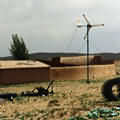除了過度開墾與過度放牧的直接破壞外,降雨量下降和超抽導致地下水位下降的情形,事實上已經使中國北半部的環境處於持續枯竭的狀態。各地的地下水位幾乎都在下降,漸漸地,各地的水力也亮起了紅燈。當地下水位下降,井也枯乾,溪不再有水,湖泊一一消失,河流也竭盡了。美國的衛星三十幾年來持續監測中國大陸的土地,而根據所得資料顯示,中國北方數以千計的湖泊已經消失。
中國社會科學院院士王宏昌(音譯)表示,中國南邊和東邊森林的消失,造成來自南海、東海和黃海的水氣傳到內陸的量減少。如果地表有森林覆蓋,森林便能涵養來自海面上的水氣,水氣也就可以傳送到內陸。當樹木植被遭移除後,降到地表的雨水和保涵水分子的空氣就會流失,直接回到海洋。當地表降雨的循環功能因森林的消失而降低時,內陸的降雨量自然減少。
改變情勢的做法
想要逆轉這些環境惡化的現象,大家就得齊一心力去控制人口量,並大量植樹,使內陸的水循環能夠有效地運作。也就是說,必須把容易造成土壤沖刷流失的耕地,復育為原本的草原和森林,並降低牲畜的飼養量,以及在耕地週邊栽種防風林,減少風的侵蝕。這就是美國農夫在1930年代沙塵暴時期的應變做法。

位於蒙古的一座風力發電渦輪機(照片提供:國家再生能源實驗/網路影像資料庫)
目前有另一個有趣的替代方案:利用風力渦輪作為風阻,有效降低風速與對土壤的侵蝕。目前風力發電的成本,能夠在市場上與利用化石燃料發電競爭了。在計劃的地區搭建幾排風力渦輪機組可以減緩風速,並大大地減少土壤因侵蝕而導致流失的情況發生。這同時提供降低當地對火力發電的依賴,大幅減緩了以木材為燃料而對森林所造成的壓力。
這其中的經濟利益更是誘人。和中國西北部有類似遭遇的美國大平原地區,當地美國人在災區建造了一座佔地五分之一英畝面地的先進大型風動渦輪,它每年可以產生值10萬美金的電力。這個郊區經濟的振興方案正符合中國希望發展貧窮西北的計畫。
改善沙漠化需要很大的努力與堅持,但是如果沙塵暴持續惡化,不僅會對經濟產生極大的衝擊,同時會導致人口大量的東移。在這樣的條件下,我們該做的選擇是很明顯的。是要減少牲畜的飼養量,使環境可以負荷,還是承受超量的牲畜。讓草原變成沙漠。是要將容易受侵蝕的耕地便回草原,還是要讓土地漸漸的失去生產力後變成沙漠。是要植樹同時建造風阻,或是在可行的情況下,建造風動渦輪來減緩風力,還是要面對更多的土壤侵蝕和沙塵暴。
如果中國不趕緊停止這股環境惡化的趨勢,沙塵暴將持續加劇,可能造成日後不可收拾的局面。這不僅關係著中國的土地,還有中國的未來。

萊斯特‧布朗是地球政策研究所的創辦人和所長,同時也是看守世界研究所(總部位於美國華盛頓特區)的創辦人和理事長。
【編按】
原文標題"Another One Bites the Dust",為搖滾樂團"Queen"著名歌曲,原意指「又倒下一人」、「兵敗如山倒」之意,此處作者取其雙關之意。
Deforestation in southern and eastern China is reducing the moisture transported inland from the South China Sea, the East China Sea, and the Yellow Sea, writes Wang Hongchang, a fellow at the Chinese Academy of Social Sciences. Where land is forested, the water is held and evaporates to be carried further inland. When tree cover is removed, the initial rainfall from the inland-moving, moisture-laden air simply runs off and returns to the sea. As this recycling of rainfall inland is weakened by deforestation, rainfall in the interior is declining.
The Winds of Change
Reversing this degradation means stabilizing population and planting trees everywhere possible to help recycle rainfall inland. It means converting highly erodible cropland back to grassland or woodland, reducing the livestock population, and planting tree shelter belts across the windswept areas of cropland, as U.S. farmers did to end dust storms in the 1930s.

A wind turbine in Mongolia. Photo: NREL/PIX.
Another interesting option now presents itself -- the use of wind turbines as windbreaks to reduce wind speed and soil erosion. With the cost of wind-generated electricity now competitive with that generated from fossil fuels, constructing rows of wind turbines in strategic areas to slow the wind could greatly reduce the erosion of soil. This also affords an opportunity to phase out the use of wood for fuel, thus lightening the pressure on forests.
The economics are extraordinarily attractive. In the U.S. Great Plains, under conditions similar to China's northwest, a large, advanced-design wind turbine occupying one-fifth of an acre of land can produce $100,000 of electricity per year. This source of rural economic regeneration fits in nicely with China's plan to develop the impoverished northwest.
Reversing desertification will require a huge effort, but if the dust bowl continues to spread, it will not only undermine the economy, but also trigger a massive migration eastward. The options are clear: Reduce livestock populations to a sustainable level or face heavy livestock losses as grassland turns to desert. Return highly erodible cropland to grassland or lose all of the land's productive capacity as it turns to desert. Construct windbreaks with a combination of trees and, where feasible, wind turbines, to slow the wind or face even more soil losses and dust storms.
If China cannot quickly arrest the trends of deterioration, the growth of the dust bowl could acquire an irreversible momentum. What is at stake is not just China's soil, but its future.

Lester R. Brown is founder and president of the Earth Policy Institute, and founder and chair of the board of the Worldwatch Institute in Washington, D.C.
其他參考資料:
1.「風中的塵埃-沙塵暴」
2.關於"dust bowl"的小故事「躲不過去的沙塵暴」
【文章連載】
■沙塵暴又一噩耗 (上) (下)
全文與圖片詳見:http://www.gristmagazine.com/maindish/brown052901.stm




